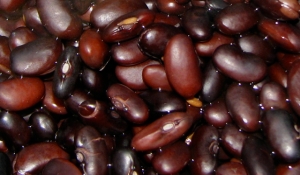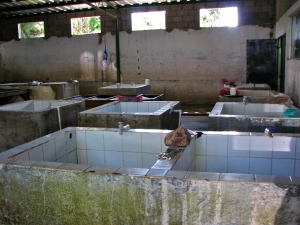Two modern slaughterhouses are in the works in the zona oriental of El Salvador - in San Miguel and Pasaquina. The idea is that these two slaughterhouses would serve the entire eastern zone of the country, thereby abolishing all of the small slaughterhouses scattered throughout the countryside. As I outlined in a previous blog post about the typical Salvadoran slaughterhouse, the conditions are unhygienic, inhumane, and environmentally damaging. They are little more than cement floors (at best) with a roof, open to the air otherwise, with no treatment for the waste being washed from the floors into a drain. The water washes away the blood, feces, and I most like bleach or other cleaners as well, directly into a nearby creek. And while many industrialized nations are still debating the best way to slaughter animals (see recent BBC news article), in these slaughterhouses, they are stabbed in the brain and then exsanguinated by slitting the throat. Nothing about these primitive slaughterhouses are good, except that they get the job done and they are numerous, so people do not have to travel very far to get their livestock slaughtered.
However, a modern slaughterhouse would ensure clean, well-treated meat was being delivered to the market, and potentially open the doors for an export market. As it is now, because El Salvador does not have any certified slaughterhouses, no meat can be exported, and the meat that large supermarkets and restaurants sell is imported - mostly from Nicaragua. So, El Salvador is losing out. Modernization could bring more sales to local farmers. However, if the entire eastern part of the country only had two slaughterhouses, it would put a strain on farmers who would need to travel great distances on poor roads to reach the slaughterhouse. This might have the opposite effect of reducing farmers' incomes because those who don't intend to export or sell to local supermarkets would now have a much higher input cost. A rancher from the San Miguel, Juan Andres Salazar, said exactly that; the costs incurred from transporting the animals to the slaughterhouse and the meat back, would make his profit margin narrow to almost nothing.
However, the debate may be moot because the process to complete the environmental impact assessments of the two proposed sites has been slow, and now that elections are on the horizon, local law prohibits the bidding process from happening for government projects during that time. Additionally, three government ministries have to approve the project - the Ministry of Health, the Ministry of the Environment and Natural Resources, and the Ministry of Agriculture and Livestock. The project is also being funded by the Social Investment Fund for Local Development, who provide further input into the project. So, nothing may move forward in terms of constructing these slaughterhouses until April of 2012. In my opinion, modernizing animal slaughter is a very important step and I am glad that the government is making an effort to do away with the unsanitary slaughterhouses. But I wonder if they couldn't modernize several small slaughterhouses instead. Apart from making life more difficult for already struggling ranchers and farmers in the poorest zone of the country, having all the region's meat concentrated in just two locations is akin to putting all your eggs in one basket. It's just not a safe food system. One sick animal that gets into the slaughterhouse could destroy thousands of pounds of otherwise perfectly edible meat. Furthermore, in a country where enforcement is practically nil, traceability becomes a major issue. If a disease is introduced, how easy will it be to find its source? This opens the doors to potential epidemics and is overall far too risky for a country such as El Salvador. Sadly, I don't think those government officials are reading my blog :)




























